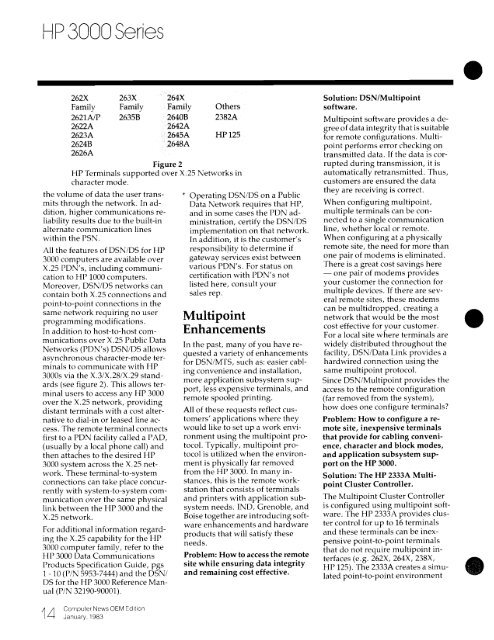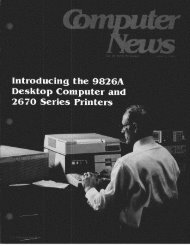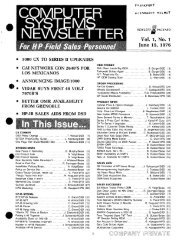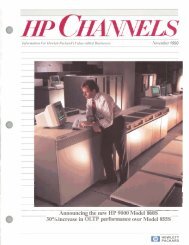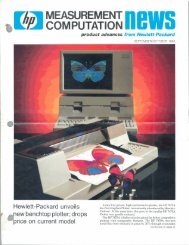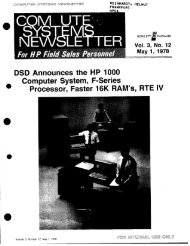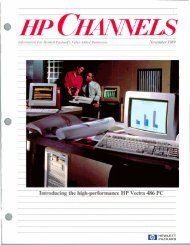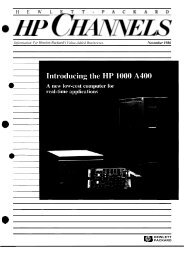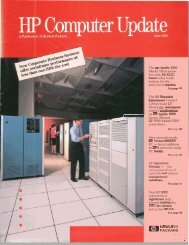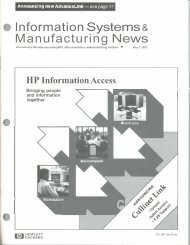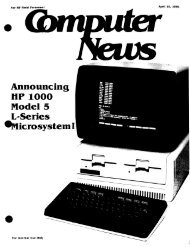edition - HP Computer Museum
edition - HP Computer Museum
edition - HP Computer Museum
Create successful ePaper yourself
Turn your PDF publications into a flip-book with our unique Google optimized e-Paper software.
<strong>HP</strong> 3000 Series<br />
262X 263X 264X<br />
Family Family Family Others<br />
2621AlP 2635B 2644B 2382A<br />
2622A<br />
2642A<br />
2623A 2645A <strong>HP</strong> 125<br />
2624B<br />
2648A<br />
2626A<br />
Figure 2<br />
<strong>HP</strong> Terminals supported over X.25 Networks in<br />
character mode.<br />
the volume of data the user transmits<br />
through the network. In addition,<br />
higher communications reliability<br />
results due to the built-in<br />
alternate communication lines<br />
within the PSN.<br />
All the features of DSNIDS for <strong>HP</strong><br />
3000 computers are available over<br />
X.25 PDN's, including communication<br />
to <strong>HP</strong> 1000 computers.<br />
Moreover, DSNIDS networks can<br />
contain both X.25 connections and<br />
point-to-point connections in the<br />
same network requiring no user<br />
programming modifications.<br />
In addition to host-to-host communications<br />
over X.25 Public Data<br />
Networks (PDN's) DSNIDS allows<br />
asynchronous character-mode terminals<br />
to communicate with <strong>HP</strong><br />
3000s via the X.3lX.28lX.29 standards<br />
(see figure 2). This allows terminal<br />
users to access any I-IP 3000<br />
over the X.25 network, providing<br />
distant terminals with a cost alternative<br />
to dial-in or leased line access.<br />
The remote terminal connects<br />
first to a PDN facility called a PAD,<br />
(usually by a local phone call) and<br />
then attaches to the desired <strong>HP</strong><br />
3000 system across the X.25 network.<br />
These terminal-to-system<br />
connections can take place concurrently<br />
with system-to-system communication<br />
over the same physical<br />
link between the <strong>HP</strong> 3000 and the<br />
X.25 network.<br />
For additional information regarding<br />
the X.25 capability for the <strong>HP</strong><br />
3000 computer family, refer to the<br />
<strong>HP</strong> 3000 Data Communications<br />
Products Specification Guide, pgs<br />
1 - 10 (PIN 5953-7444) and the DSNI<br />
DS for the <strong>HP</strong> 3000 Reference Manual<br />
(PIN 32190-90001)<br />
* Operating DSNIDS on a Public<br />
Data Network requires that <strong>HP</strong>,<br />
and in some cases the PDN administration,<br />
certify the DSNIDS<br />
implementation on that network.<br />
In addition, it is the customer's<br />
responsibility to determine if<br />
gateway services exist between<br />
various PDN's. For status on<br />
certification with PDN's not<br />
listed here, consult your<br />
sales rep.<br />
Multipoint<br />
Enhancements<br />
In the past, many of you have requested<br />
a variety of enhancements<br />
for DSNIMTS. such as: easier cabling<br />
convenience and installation,<br />
more application subsystem support,<br />
less expensive terminals, and<br />
remote spooled printing.<br />
All of these requests reflect customers'<br />
applications where they<br />
would like to set up a work environment<br />
using theAmultipoint protocol.<br />
Typically, multipoint protocol<br />
is utilized when the environment<br />
is physically far removed<br />
from the <strong>HP</strong> 3000. In many instances,<br />
this is the remote workstation<br />
that consists of terminals<br />
and printers with application subsystem<br />
needs. IND, Grenoble, and<br />
Boise together are introducing software<br />
enhancements and hardware<br />
products that will satisfy these<br />
needs.<br />
Problem: How to access the remote<br />
site while ensuring data integrity<br />
and remaining cost effective.<br />
Solution: DSNlMultipoint<br />
software.<br />
Multipoint software provides a degree<br />
of data integrity that is suitable<br />
for remote configurations. Multipoint<br />
performs error checking on<br />
transmitted data. If the data is corrupted<br />
during transmission, it is<br />
automatically retransmitted. Thus,<br />
customers are ensured the data<br />
they are receiving is correct.<br />
When configuring multipoint,<br />
multiple terminals can be connected<br />
to a single communication<br />
line, whether local or remote.<br />
When configuring at a physically<br />
remote site, the need for more than<br />
one pair of modems is eliminated.<br />
~heie is a great cost savings here<br />
- one pair of modems provides<br />
your customer the connection for<br />
multi~le devices. If there are sev-<br />
1<br />
era1 remote sites, these modems<br />
can be multidropped, creating a<br />
network that would be the most<br />
cost effective for vour customer.<br />
For a local site where terminals are<br />
widely distributed throughout the<br />
facility, DSNlData Link provides a<br />
hardwired connection using the<br />
same multipoint protocol.<br />
Since DSNlMultipoint provides the<br />
access to the remote configuration<br />
(far removed from the system),<br />
how does one configure terminals<br />
Problem: How to configure a remote<br />
site, inexpensive terminals<br />
that provide for cabling convenience,<br />
character and block modes,<br />
and application subsystem support<br />
on the <strong>HP</strong> 3000.<br />
Solution: The <strong>HP</strong> 2333A Multipoint<br />
Cluster Controller.<br />
The Multipoint Cluster Controller<br />
is configured using multipoint software.<br />
The <strong>HP</strong> 2333A provides cluster<br />
control for up to 16 terminals<br />
and these terminals can be inexpensive<br />
point-to-point terminals<br />
that do not require multipoint interfaces<br />
(e.g. 262X, 264X, 238X,<br />
<strong>HP</strong> 125). The 2333A creates a simulated<br />
point-to-point environment<br />
<strong>Computer</strong> News OEM Edt~on<br />
1 4 January, 1983


